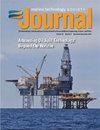Quantifying Self-Noise of the Seaglider AUV Using a Passive Acoustic Monitor
IF 0.7
4区 工程技术
Q4 ENGINEERING, OCEAN
引用次数: 0
Abstract
Abstract The Seaglider, a type of underwater glider, is a relatively quiet vehicle in comparison with propelled autonomous underwater vehicles, making it a desirable acoustic receiving platform. Vehicle operations, such as pumping/bleeding oil to change buoyancy, shifting/rotating the battery to change pitch/roll, and oceanographic data collection, do, however, produce some self-noise. This system performance study analyzes the prevalence, frequency content, duration, and levels of self-noise associated with vehicle operations using data collected with a passive acoustic monitoring system mounted on the body of a Seaglider vehicle. Guidance and control functions, including pitch, roll, and buoyancy changes, were the major source of platform noise, producing broadband noise ranging from less than a second to over 3 min in duration, with sound pressure levels of 120‐145.5 dB re 1μPa. Frequencies below 10 kHz were the most impacted by self-noise, with a maximum 1/3 octave level of 137.5 dB re 1μPa in the 2.5kHz band caused by the pumping of oil in the variable buoyancy device. Guidance and control changes occurred during 4%‐13% of the dive for dives greater than 500 m. The bulk of these operations, however, were performed near the surface and apogee of the dive and typically affected only about 6% of the dive cycle duration for deep dives.利用被动式声学监测仪量化滑翔机水下航行器的自噪声
与推进式自主水下航行器相比,滑翔机是一种相对安静的水下航行器,是理想的声学接收平台。然而,车辆操作,如泵注/放油以改变浮力,移动/旋转电池以改变俯仰/横摇,以及海洋数据收集,确实会产生一些自噪声。该系统性能研究分析了与车辆运行相关的自噪声的普遍性、频率内容、持续时间和水平,使用安装在Seaglider车辆车身上的被动声学监测系统收集的数据。包括俯仰角、横摇和浮力变化在内的制导和控制功能是平台噪声的主要来源,产生的宽带噪声持续时间从不到1秒到超过3分钟,声压级为120‐145.5 dB / 1μPa。在10 kHz以下频率受自噪声影响最大,在2.5kHz频段由变浮力装置抽油引起的自噪声最大1/3倍频级为137.5 dB re 1μPa。在超过500米的潜水中,引导和控制发生变化的时间为4% ~ 13%。然而,这些操作中的大部分都是在潜水的表面和远地点附近进行的,通常只影响深潜周期持续时间的6%左右。
本文章由计算机程序翻译,如有差异,请以英文原文为准。
求助全文
约1分钟内获得全文
求助全文
来源期刊

Marine Technology Society Journal
工程技术-工程:大洋
CiteScore
1.70
自引率
0.00%
发文量
83
审稿时长
3 months
期刊介绍:
The Marine Technology Society Journal is the flagship publication of the Marine Technology Society. It publishes the highest caliber, peer-reviewed papers, six times a year, on subjects of interest to the society: marine technology, ocean science, marine policy, and education.
 求助内容:
求助内容: 应助结果提醒方式:
应助结果提醒方式:


